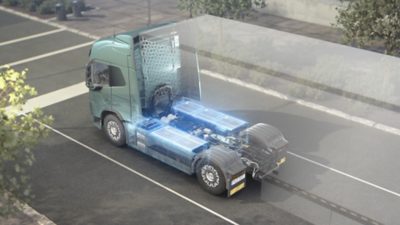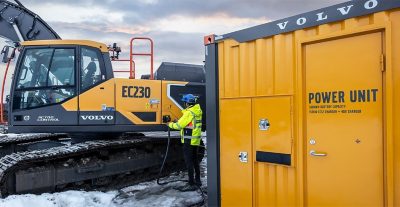If a battery no longer meets the requirements for powering a heavy truck, that doesn’t mean it’s lost its use. The second life of a truck’s battery can be every bit as useful and productive as its first. Here’s how.
Truck batteries are powerful pieces of technology. They have to be: transportation assignments depend on the range and power that the trucks provide. They’re also recharged very often. Overall, they get a lot of use. And they behave like other batteries do: no matter where you find them.
“A battery has a life expectancy - like in your any device that you use, like a phone,” says Luis Jimenez Imaz, Product Manager working with batteries at Volvo Trucks. “They’re monitored all the time, and after a number of years truck batteries might not be able to give enough energy to the trucks.” When this happens, the first thing to do is ensure that the owner of the truck can still get the best possible performance out of their vehicle. “We don’t just build trucks: we provide a service to our customers.”
If there’s a problem with the battery which is affecting its performance, repairs and refurbishment may be possible. “One of the scenarios is in which a battery no longer delivers the level of minimum usable energy promised in the Service Contract. In this case it is an early failure: it could be software or coolant issues, or other things which are not related to the battery’s main components. In many of these instances, the battery can be repaired, and provided to customers with the performance level promised in the Service Contract.”
The health of a battery – how much energy it can reliably put out, compared to how much energy it can put out in its brand-new state – is measurable. “Battery health really comes down to usable energy,” says Luis. Prolonged use of batteries might cause their health to drop over time, and one of the jobs automotive manufacturers can do is optimize the conditions which cause this. For example, by tailoring the state of charge of the battery.
But sometimes, the battery’s health drops below the level suitable for all of the applications required for a heavy-duty truck. And it’s here that we move onto the second-life scenario. “This is still a discussion, not a decision. It's benficial if batteries can be made available after their first use to refurbish or potentially to remanufacture, because of environmental impact, cost impact, and availability. The required or standard state of health of batteries is quite high for automotive applications, but batteries that fall below this level can still be very valuable for other applications. We’re trying to take advantage of this and secure the maximum usage of those batteries.”
When this happens, the battery is still an advanced, high-functioning piece of equipment. So in this instance, it’s time to work out how to give it a new life outside of the truck.
Niklas Thulin is the head of direct sales at Volvo Energy: Volvo Group’s newest business area, but one which has grown quickly in size and stature. Volvo Energy’s main purpose is to accelerate the Group’s sustainability and electrification journey, and a main area of focus is vehicle batteries. Specifically, to repair, refurbish, recycle and repurpose them.
He says: “A big contribution is to ensure that we, as a Group, have a good circularity solution for one of the most critical components of this transition: which is the battery. A subset of what we do is making batteries useful for other applications, such as battery energy storage systems”
“We are approaching two sub-segments of the battery energy storage system market. One is for temporary power and charging. You can envision a ten-foot container with integrated DC fast charger and a number of these battery packs inside. A robust, easy-to-move solution enabling fast charging in construction sites and other places where grid charging is limited.” These units also provide an opportunity for the customer to test new solutions: “By using one of these Power Units temporarily, a truck customer can evaluate whether fast charging is a good fit for their intended electric truck operation or routes without having to make any immediate grid updates.”
These handy charging units are already being put to work for Volvo Group customers, but they’re not the only way to give batteries a new lease of life. Niklas continues: “The second storage solution is more stationary and with higher capacity. It can be used in for example a truck depot, a hospital or a school. By installing one of these battery systems you get more flexibility in how you consume your power. You can buy electricity at off-peak hours, manage power peaks and demand charges, as well as maximize the use of local solar. It’s also a backup for if the grid fails. Finally, the storage can sometimes be bid into different grid markets creating actual revenue. By combining these values, the overall business case for this kind of storage facility is generally attractive.”
Volvo’s history of working with electromobility is a benefit here. Years’ worth of research and development, as well as the assembly of battery packs themselves, provide essential know-how and procedures. But the company’s global reach can also not be underestimated. As Niklas says: “We believe we are well positioned for building this business. The facilities of current Volvo customers are also potential storage installations. With our reach and customer base, extending into storage is an attractive step.”
Times are changing. As Luis Jimenez Imaz puts it: “We are pioneers in our industry when it comes to electromobility, and there are a lot of things that are changing.” As the shift towards electromobility continues to pick up pace, the industry will change beyond what many of us can predict. But one thing we can say for sure is that an exponential increase in the number of batteries being produced opens up new avenues for manufacturers and their customers. And the idea of making sure that these batteries have a fully productive second life, as well as a fully productive first life, is loaded with opportunities.




